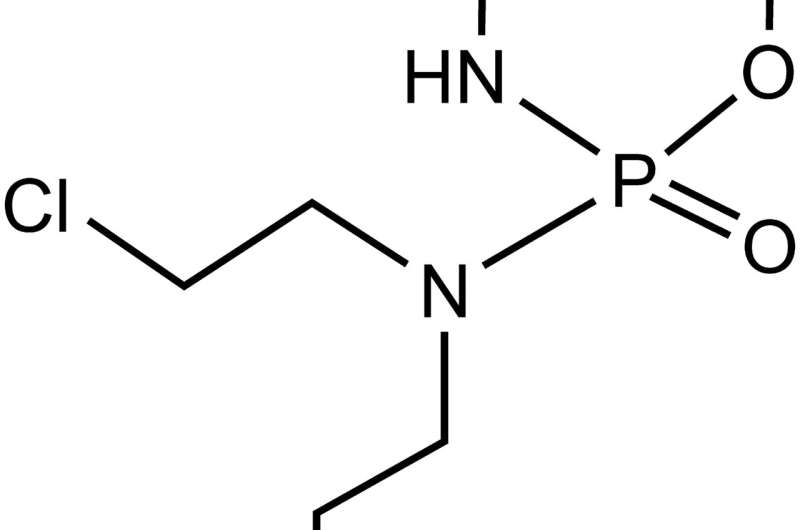This article has been reviewed according to Science X's editorial process and policies. Editors have highlighted the following attributes while ensuring the content's credibility:
fact-checked
proofread
Cytotoxic properties of cyclophosphamide: A focus on its mechanistic impacts on male gonadal functions

Cyclophosphamide (CP), a widely used chemotherapeutic and immunosuppressive agent, has significant impacts on reproductive health in both males and females. A review published in the Journal of Exploratory Research in Pharmacology explores the mechanisms and outcomes of CP-induced reproductive toxicity, emphasizing its effects on genetic stability, hormonal balance, and gonadal function.
CP is known for its effectiveness in treating various cancers and autoimmune disorders. However, its clinical use is marred by severe side effects, particularly on reproductive health. CP enhances the expression of DNA-binding proteins such as SSRP1, HNRNPK, and PURA, contributing to cytotoxicity and male infertility.
Alterations in ornithine decarboxylase expression and polyamine concentrations further inhibit sperm capability, underscoring the profound genetic instability caused by CP. These changes are critical as they lead to disrupted spermatogenesis and potential transmission of genetic abnormalities to offspring.
One of the most evident impacts of CP is a significant decrease in testis weight and transient oligozoospermia. CP disrupts DNA, RNA, and protein synthesis in spermatids, essential for normal sperm development and function. Studies in both human and animal models have shown CP-induced birth defects and chromosomal translocations, indicating that the effects of CP are not only severe but also heritable. This means that the genetic damage caused by CP can persist into subsequent generations, causing a ripple effect of reproductive challenges.
The hormonal disturbances induced by CP play a critical role in its reproductive toxicity. CP decreases the activity of steroidogenic enzymes, leading to lowered levels of testosterone, luteinizing hormone (LH), and follicle-stimulating hormone (FSH). These hormonal imbalances result in significant reductions in testicular weight and cause histopathological abnormalities, including seminiferous tubule degeneration and germ cell apoptosis.
Additionally, CP increases oxidative stress and induces mitochondrial dysfunction, which are primary factors contributing to abnormal sperm morphology, reduced concentration, and motility. These changes collectively impair fertility and highlight the extensive damage CP inflicts on the male reproductive system.
In females, CP's cytotoxic properties are equally concerning. The drug suppresses ovarian endocrine activity, leading to various reproductive complications, including amenorrhea (absence of menstruation), precocious puberty, and menopausal symptoms. CP's impact extends to long-term fertility, where permanent infertility, decreased ovarian reserve, and an increased risk of osteoporosis are notable consequences.
CP interferes with the hypothalamic-pituitary-gonadal axis, disrupting normal ovulatory cycles and estrogen-dependent reproductive processes. This interference not only affects fertility but also impacts overall health, given the crucial role of estrogen in various physiological functions.
Understanding the mechanisms of CP-induced reproductive toxicity is crucial for developing protective strategies. Clinical approaches such as sperm banking and ovarian tissue preservation are recommended for patients undergoing CP treatment.
Additionally, research into pharmacological agents that can mitigate CP's toxic effects on the reproductive system is ongoing. Antioxidants and hormone replacement therapies are being explored to counteract oxidative stress and hormonal imbalances, respectively. These strategies aim to preserve fertility and improve the quality of life for patients undergoing CP therapy.
The cytotoxic properties of CP have profound and lasting effects on reproductive health, necessitating informed clinical decisions to mitigate these risks. Health care providers must balance the therapeutic benefits of CP with its potential to cause long-term reproductive harm. Ongoing research into protective strategies and alternative treatments is essential to minimize these adverse effects and support the reproductive health of patients.
Understanding the mechanisms of CP-induced toxicity is crucial for developing effective interventions and improving reproductive outcomes in affected patients.
More information: Temitope G. Olowe et al, Cytotoxic Properties of Cyclophosphamide: A Focus on Its Mechanistic Impacts on Male Gonadal Functions, Journal of Exploratory Research in Pharmacology (2024). DOI: 10.14218/JERP.2023.00025S





















